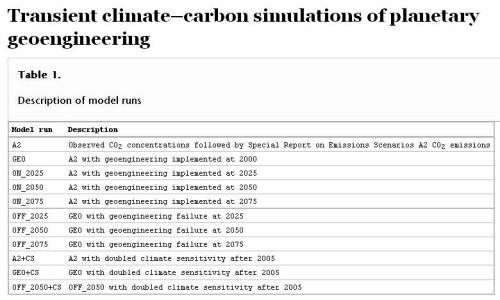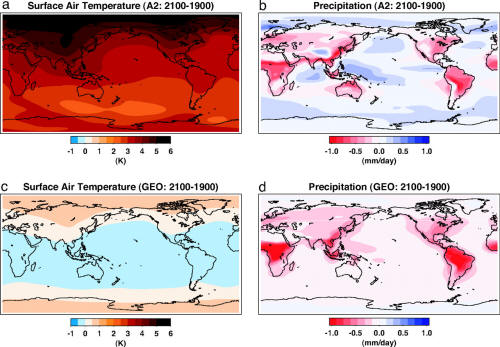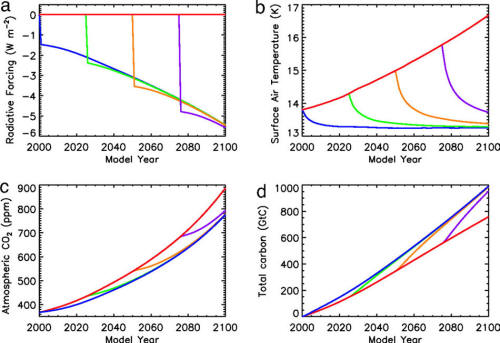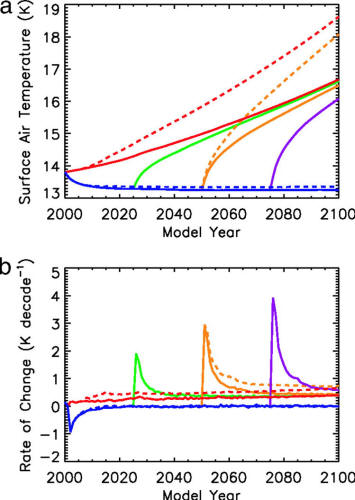|
|
|
Carnegie Institution of Washington, from ProceedingsOfTheNationalAcademyOfSciences Website
Most proposals involve managing incoming solar radiation such that future greenhouse gas forcing is counteracted by reduced solar forcing. In this study, we assess the transient climate response to geoengineering under a business-as-usual CO2 emissions scenario by using an intermediate-complexity global climate model that includes an interactive carbon cycle.
We find that the climate system responds quickly to artificially reduced insolation; hence, there may be little cost to delaying the deployment of geoengineering strategies until such a time as “dangerous” climate change is imminent. Spatial temperature patterns in the geoengineered simulation are comparable with preindustrial temperatures, although this is not true for precipitation.
Carbon sinks in the model increase in response to geoengineering. Because geoengineering acts to mask climate warming, there is a direct CO2-driven increase in carbon uptake without an offsetting temperature-driven suppression of carbon sinks.
However, this strengthening of carbon sinks, combined with the potential for rapid climate adjustment to changes in solar forcing, leads to serious consequences should geoengineering fail or be stopped abruptly. Such a scenario could lead to very rapid climate change, with warming rates up to 20 times greater than present-day rates. This warming rebound would be larger and more sustained should climate sensitivity prove to be higher than expected.
Thus,
employing geoengineering schemes with continued carbon emissions
could lead to severe risks for the global climate system.
Although it is not certain what or
how serious the impacts of climate change will be over the next
century, there will be increasing impacts on human societies and the
environment.
It is perhaps not surprising that there has been recent
renewed interest in possible top-down technological fixes of the
climate/energy problem designed to restrict climate warming by
intentionally counteracting the radiative effects of anthropogenic
greenhouse gases (2, 3).
In 1992, the U.S. National Academy of Sciences published a report on the policy implications of global warming in which a full chapter was devoted to the technical feasibility and possible implications of various geoengineering proposals (4).
In recent literature, the term “geoengineering” has most often been used to refer to techniques to reduce absorption of incoming solar radiation, via schemes such as the injection of reflective aerosols into the stratosphere (2 and 3).
Other proposals to manage incoming solar radiation have included the manufacture and deployment of space-based solar reflectors and large-scale cloud seeding to increase the distribution of marine stratocumulus clouds (4).
Geoengineering has also been used to describe the management of carbon sinks, for example, through large-scale reforestation, ocean fertilization, or carbon capture with direct ocean injection (5, 6).
However, we
emphasize that there is an important difference between managing
solar radiation and managing carbon sinks; for the purposes of this
paper, we restrict our definition of geoengineering to refer to
planetary-scale efforts to reduce the absorption of incoming
sunlight.
Even less is known, however, about the climate implications of geoengineering. Proposed schemes to reduce incoming solar radiation (3) have drawn on the climatic effect of large volcanic eruptions (e.g., Mt. Pinatubo in 1991), which inject sulfate aerosols into the stratosphere and generate global cooling of a few tenths of a degree for several years after an eruption (7).
By extension, it is possible that deliberate (and
repeated) injection of aerosols into the stratosphere would affect a
long-term cooling that could compensate for some (or perhaps all) of
the climate warming induced by anthropogenic greenhouse gases.
In a subsequent study, the authors showed that the global biospheric effects of reduced insolation may be small in comparison to the possible fertilization of terrestrial ecosystems from elevated atmospheric CO2 (9).
However, these studies were carried out in the
context of idealized doubled CO2 experiments, which did not capture
the time-dependent implications for the climate system of a world
subject to both continued CO2 emissions and large-scale
geoengineering.
We used the University of Victoria Earth System Climate Model (UVic ESCM) (10), which is an intermediate complexity global model with explicit representations of ocean circulation and heat uptake, sea-ice dynamics, atmospheric energy and moisture balances, and terrestrial vegetation distributions (see Methods).
Furthermore, the UVic ESCM includes a prognostic global carbon cycle that allows quantification of the carbon cycle response to geoengineering.
We present results from a business-as-usual carbon emissions scenario in which geoengineering is implemented some time between the year 2000 and the year 2075. We also present simulations in which geoengineering is implemented immediately and then terminated abruptly in the future, either as a result of system failure or because of the discovery of unforeseen or unacceptable environmental consequences.
Finally, we discuss how current uncertainties in the climate response to anthropogenic forcing could manifest in a geoengineered world (see list of model runs in Table 1).
Table 1
Results
The spatial pattern of warming is shown in Fig. 1 a, with warming ranging from 2.5°C in the southern Pacific to >5°C at high northern latitudes. By contrast, global temperatures at 2100 in the fully geoengineered simulation (GEO) were very close to year-1900 levels, with regional temperature changes varying from -0.35°C in the tropical Pacific to less than +1.0°C in the Arctic (Fig. 1c).
This distribution of warming and cooling in GEO is the result of a globally uniform factor applied to incoming solar radiation (see Methods), which resulted in a greater absolute reduction in incoming solar radiation in the Tropics relative to the poles.
As a consequence, there was a
small reduction in the equator-to-pole temperature gradient in GEO
relative to preindustrial conditions, although this decrease was
only about half of the change simulated in the A2 simulation.
Fig. 1. at 2100 relative to 1900 for model runs A2 (a and b) and GEO (c and d).
Plots show
differences in 10-year averages centered on 2095 and 1895,
respectively. Spatial changes in precipitation are perhaps more interesting.
In the A2 simulation, globally averaged precipitation decreased slightly by 0.02 mm/day from 1900 to 2100, with increased precipitation over oceans (due to warming) counteracted by decreased precipitation over land (Fig. 1 b).
Land precipitation decreases can be explained by the effect of elevated CO2 on plant photosynthesis, whereby plants use soil water more efficiently and evapotranspiration is reduced in a high-CO2 world (11).
In GEO, however, the atmosphere did not warm appreciably at
2100 relative to 1900; consequently, the direct effect of elevated
CO2 on evapotranspiration was the dominant driver of precipitation
changes. Global averaged precipitation decreased by 0.18 mm/day from
1900 to 2100, with the largest regional decreases (up to 1.0 mm/day)
over tropical land areas (Fig. 1 d).
For all geoengineering runs, global temperature responded quickly to changes
in incoming solar radiation; temperature decreased toward
preindustrial temperatures in all cases with an e-folding time scale
of ≈5 years.
Fig. 2. simulated globally averaged surface air temperature (b), simulated atmospheric CO2 (c), and simulated change in combined land and ocean carbon storage (d)
for runs A2 (red),
GEO (blue), ON_2025 (green), ON_2050 (orange), and ON_2075 (purple). Fig. 2c shows the simulated atmospheric CO2 for the same five model runs.
The airborne fraction of CO2 emissions was simulated as a function of terrestrial and oceanic carbon sinks, which themselves evolved in the model as a function of changes in atmospheric CO2 and climate. In previous model simulations, both terrestrial and oceanic carbon sinks have been shown to increase as a function of atmospheric CO2 levels, although this increase is offset by climate changes, which tend to reduce carbon uptake (so-called positive climate-carbon cycle feedbacks; see Methods) (12).
Geoengineering in these simulations tended to return global temperatures toward preindustrial levels; as global temperatures decreased, both terrestrial and ocean carbon sinks became stronger (Fig. 2d).
As a result, atmospheric CO2 levels in geoengineered runs were lower: at 2100, atmospheric CO2 in GEO was 110 ppm by volume (12.5%) lower than in A2. CO2 levels in ON_2025, ON_2050, and ON_2075 followed the A2 scenario until the onset of geoengineering, at which point they converged with CO2 levels in GEO as carbon sinks strengthened in response to global cooling.
This
artificial strengthening of carbon sinks was not permanent, however,
and persisted in the model only as long as geoengineering was
continued.
In runs where geoengineering was stopped abruptly (OFF_2025, OFF_2050, and OFF_2075), global temperatures converged rapidly with the non-geoengineered climate (A2) (Fig. 3a). This warming rebound resulted in several years of very rapid climate change, with annual temperature changes reaching 4°C per decade in the case of OFF_2075 (Fig. 3b). This rate of temperature change is ≈20 times the current rate of climate warming (0.2°C per decade).
The peak rate of warming
associated with geoengineering failure at 2025 was less (2°C per
decade) but still on the order of 10 times the rate of current
climate change.
Fig. 3. for runs A2 (red), GEO (BLUE), OFF_2025 (green), OFF_2050 (orange), and OFF_2075 (purple).
Runs with doubled
climate sensitivity (A2+CS, GEO+CS, and OFF_2050+CS) are plotted as
dashed lines. Fig. 3 also shows results from simulations in which climate sensitivity was approximately doubled after the year 2005 (A2+CS, GEO+CS, and OFF_2050+CS; dashed lines).
Interestingly, increasing climate sensitivity did not affect the geoengineered radiative forcing required to prevent CO2-induced warming, because the magnitude of CO2 forcing was unchanged in the doubled climate sensitivity runs. Therefore, the “effectiveness” of geoengineering in these runs was independent of climate sensitivity. However, in a stabilized climate there is also no way of knowing how large climate sensitivity actually is until geoengineered forcing is removed.
These implications of a world with high climate sensitivity are illustrated in Fig. 3.
Higher climate sensitivity in OFF_2050+CS
resulted in larger and more sustained rapid warming upon failure of geoengineering than in the lower climate sensitivity simulation.
Neglecting technical and scientific uncertainties regarding the deployment and effectiveness of schemes aimed at reducing incoming solar radiation, we have shown here that a uniform reduction of insolation is capable of counteracting most of the regional surface warming resulting from anthropogenic CO2. This is not true, however, of precipitation changes.
Previous studies (8, 9) did not report significant changes in precipitation patterns between geoengineering and control climate simulations; however, these studies did not consider the direct effect of elevated CO2 on the hydrological cycle via changes in plant water use efficiency. As we have shown here, in the absence of climate warming, elevated CO2 had a dominant effect on regional precipitation anomalies, with the result that there were large decreases in precipitation over vegetated land surfaces, particularly in the Tropics.
This result carries important
implications for other aspects of the hydrological system,
particularly soil water storage and surface runoff, which have
themselves been demonstrated to be affected by the direct effect of
elevated CO2 on evapotranspiration (13).
It is also notable that future carbon sinks, as well as feedbacks between climate change and the carbon cycle, play a strong role in affecting how much geoengineering is required to counteract the CO2 radiative forcing that results from a given emissions scenario. Recent studies have highlighted the large uncertainty in the magnitude of future carbon cycle feedbacks; for example, at the year 2100, simulated atmospheric CO2 levels have varied by >300 ppm by volume in response to the same CO2 emissions scenario (12).
This large uncertainty is directly relevant to
attempts to geoengineer the climate system. If future carbon sinks
are stronger (weaker) than anticipated, then the amount of
geoengineering required to offset CO2 emissions will be
overestimated (underestimated).
The consequent acceleration of atmospheric CO2 accumulation in the model runs shown here contributed to the very high rates of temperature change (2-4°C per decade) plotted in Fig. 3 as global climate warmed in response to the unmasking of CO2 forcing.
It is worth emphasizing that the current rate of climate change (0.2°C per decade) is already high relative to reconstructed estimates of rates of paleotemperature changes. Estimates of local warming rates in the northern Atlantic during the Dansgaard-Oeschger events of the last glacial period have been estimated to be in the range of 8-16°C over several decades.
However, warming rates in the
Antarctic were much smaller (1-3°C on millennial time scales);
therefore, there is no evidence that global temperature changes have
approached 2-4°C per decade at any time over the last several
glacial cycles (14).
Furthermore, the potential for high rates of climate change associated with the onset and/or failure of geoengineering would be even more of a concern should the international coordination of the deployment of geoengineering schemes prove to be challenging. In the case of inconsistent or erratic deployment (either because of shifting public opinions or unilateral action by individual nations), there would be the potential for large and rapid temperature oscillations between cold and warm climate states. It is also likely that such scenarios would lead to uneven spatial application of geoengineering, as opposed to the spatially uniform reduction of solar radiation used in our experiments.
Temporally and spatially patchy attempts at geoengineering would pose significant challenges to adaptation by
human societies and natural ecosystems.
If climate sensitivity turns out to be on the high end of current estimates [which have not been able to rule out climate sensitivities as large as 8-10°C for a doubling of CO2 (15)], the difference between temperatures resulting from a geoengineered climate and temperatures in the absence of geoengineering would be substantially larger.
Furthermore, because
the amount of geoengineered forcing required to neutralize a given
CO2 increase is independent of climate sensitivity, there would be
no obvious way of predicting the magnitude of the consequences of
abrupt geoengineering failure (which depend highly on climate
sensitivity).
Further study is required to determine how atmospheric chemistry and the lifetime of non-CO2 greenhouse gases might be affected by changes in solar radiative fluxes. There also are unresolved concerns that geoengineering proposals involving sulfate aerosols may have negative consequences for stratospheric ozone levels.
There is the potential for additional carbon cycle responses to geoengineering beyond those shown here, such as the effects on biological systems that might result from changes in the partitioning of direct and diffuse radiation. More generally, one of the effects of geoengineering (by design) is to decouple levels of greenhouse gases in the atmosphere from global surface temperatures.
These two quantities have been
strongly coupled throughout the Earth's recent history (16), and it is not clear how biological systems may respond to a
change in the global relationship between atmospheric CO2 and
temperature.
Opponents of immediate climate mitigation actions might argue for a delay in emission reductions based on a lack of trust in climate model predictions.
However, reliance on geoengineering implies a
larger trust in climate model results than does reliance on
emissions reductions. For example, even if there were only a 50%
probability that climate model predictions are approximately
correct, reducing emissions could be a prudent avoidance of risk.
However, if we had only 50% confidence in climate model predictions
of the efficacy of geoengineering schemes, then reliance on
geoengineering is likely to be imprudent.
It is possible, however, that increased anthropogenic interference in the climate system (even in the form of geoengineering) could result in a net increase of global impacts on human and environmental systems.
As current climate impacts continue to manifest over the next several years, calls for geoengineering fixes to the climate/energy problem may become louder and more widespread. It is critical that the climatic consequences of geoengineering schemes be comprehensively explored before deployment of such schemes are considered.
It is equally critical
that efforts to mitigate greenhouse gas emissions do not become
hampered or slowed by the specter of false certainty in our ability
to geoengineer the climate change problem away.
Horizontal resolution is 1.8° latitude by 3.6° longitude; water, heat, and carbon are all conserved to machine precision without the use of flux adjustments. Land and terrestrial vegetation are represented by a simplified version of the Hadley Centre's MOSES2 land surface model coupled to the dynamic vegetation model TRIFFID (18, 19).
Ocean biology was simulated by using a simple NPZD model (20), with
air-sea carbon fluxes computed according to the OCMIP abiotic
protocol (10, 21); land carbon fluxes were calculated within MOSES2
and were allocated to soil and vegetation carbon pools within the
five plant functional types supported by TRIFFID.
Simulated processes that contribute to an overall positive
climate-carbon cycle feedback included accelerated soil carbon
decomposition, decreased tropical vegetation productivity with
temperature increases, and the effect of climate warming on ocean
carbon solubility, ocean circulation (solubility pump), and
biological productivity (biological pump) (22).
Geoengineering was represented by a factor (Kg) applied to incoming solar radiation, computed to satisfy,
...where STOA is the globally averaged top of atmosphere solar flux, αP is the planetary albedo, and F is a constant equal to 5.35 W/m2.
To balance the radiative forcing from doubled CO2 required a decrease in incoming solar radiation of 3.7 W/m2, corresponding to a K g of ≈ 0.016.
When geoengineering was “on”
in a model run, Kg was calculated at each time step to follow
increasing atmospheric CO2, and incoming solar radiation at every
grid cell was multiplied by (1 - Kg) such that Eq. 1 was satisfied
in the global average. Global temperatures in the model responded to
this geoengineered forcing by returning to preindustrial conditions.
All runs were spun up to a near-stationary equilibrium under preindustrial CO2 and then driven by observed CO2 concentrations (23) to the year 2000. From 2000 to 2100, CO2 emissions from fossil fuels and land-use change were specified from the Special Report on Emissions Scenarios A2 scenario (24).
Other climate forcings, both
anthropogenic (non-CO2 greenhouse gases and land cover change) and
natural (insolation and volcanic aerosols) were neglected in these
simulations. Geoengineering was applied to or removed from a
simulation instantaneously.
In these runs (A2+CS, GEO+CS, and OFF_2050+CS), climate sensitivity was modified after the year 2005 by means of an adjustable temperature-longwave radiation feedback:
...where Lout is the unmodified outgoing longwave radiation and L*out is the new outgoing longwave radiation reduced at each time step as a function of the difference between globally averaged surface air temperature and the equilibrium preindustrial temperature (T - T0).
This parametrization was chosen based on a formulation of climate sensitivity as the sum of the response to direct CO2 forcing and net effect of climate feedbacks.
Eq. 2 serves to increase the net climate feedback by damping the increase in outgoing longwave radiation with increased surface temperature (mimicking, for example, a strong positive cloud feedback).
The value of the
constant parameter KLW was selected such that the equilibrium
climate sensitivity (the global temperature response to doubled CO2
after >2,000 years of model integration) was approximately doubled.
|





